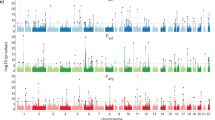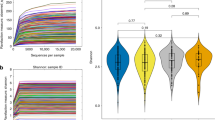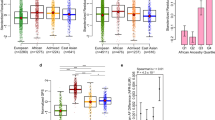Abstract
Human leukocyte antigen (HLA) genes confer substantial risk for autoimmune diseases on a log-additive scale. Here we speculated that differences in autoantigen-binding repertoires between a heterozygote's two expressed HLA variants might result in additional non-additive risk effects. We tested the non-additive disease contributions of classical HLA alleles in patients and matched controls for five common autoimmune diseases: rheumatoid arthritis (ncases = 5,337), type 1 diabetes (T1D; ncases = 5,567), psoriasis vulgaris (ncases = 3,089), idiopathic achalasia (ncases = 727) and celiac disease (ncases = 11,115). In four of the five diseases, we observed highly significant, non-additive dominance effects (rheumatoid arthritis, P = 2.5 × 10−12; T1D, P = 2.4 × 10−10; psoriasis, P = 5.9 × 10−6; celiac disease, P = 1.2 × 10−87). In three of these diseases, the non-additive dominance effects were explained by interactions between specific classical HLA alleles (rheumatoid arthritis, P = 1.8 × 10−3; T1D, P = 8.6 × 10−27; celiac disease, P = 6.0 × 10−100). These interactions generally increased disease risk and explained moderate but significant fractions of phenotypic variance (rheumatoid arthritis, 1.4%; T1D, 4.0%; celiac disease, 4.1%) beyond a simple additive model.
This is a preview of subscription content, access via your institution
Access options
Subscribe to this journal
Receive 12 print issues and online access
$209.00 per year
only $17.42 per issue
Buy this article
- Purchase on Springer Link
- Instant access to full article PDF
Prices may be subject to local taxes which are calculated during checkout



Similar content being viewed by others
References
Horton, R. et al. Gene map of the extended human MHC. Nat. Rev. Genet. 5, 889–899 (2004).
Parkes, M., Cortes, A., van Heel, D.A. & Brown, M.A. Genetic insights into common pathways and complex relationships among immune-mediated diseases. Nat. Rev. Genet. 14, 661–673 (2013).
Trowsdale, J. & Knight, J.C. Major histocompatibility complex genomics and human disease. Annu. Rev. Genomics Hum. Genet. 14, 301–323 (2013).
Thursz, M.R., Thomas, H.C., Greenwood, B.M. & Hill, A.V. Heterozygote advantage for HLA class-II type in hepatitis B virus infection. Nat. Genet. 17, 11–12 (1997).
Carrington, M. et al. HLA and HIV-1: heterozygote advantage and B*35-Cw*04 disadvantage. Science 283, 1748–1752 (1999).
Penn, D.J., Damjanovich, K. & Potts, W.K. MHC heterozygosity confers a selective advantage against multiple-strain infections. Proc. Natl. Acad. Sci. USA 99, 11260–11264 (2002).
Savage, A.E. & Zamudio, K.R. MHC genotypes associate with resistance to a frog-killing fungus. Proc. Natl. Acad. Sci. USA 108, 16705–16710 (2011).
Dean, M., Carrington, M. & O'Brien, S.J. Balanced polymorphism selected by genetic versus infectious human disease. Annu. Rev. Genomics Hum. Genet. 3, 263–292 (2002).
Lipsitch, M., Bergstrom, C.T. & Antia, R. Effect of human leukocyte antigen heterozygosity on infectious disease outcome: the need for allele-specific measures. BMC Med. Genet. 4, 2 (2003).
Woelfing, B., Traulsen, A., Milinski, M. & Boehm, T. Does intra-individual major histocompatibility complex diversity keep a golden mean? Phil. Trans. R. Soc. Lond. B 364, 117–128 (2009).
Tsai, S. & Santamaria, P. MHC class II polymorphisms, autoreactive T-cells and autoimmunity. Front. Immunol. 4, 321 (2013).
Goyette, P. et al. High-density mapping of the MHC identifies a shared role for HLA-DRB1*01:03 in inflammatory bowel diseases and heterozygous advantage in ulcerative colitis. Nat. Genet. 47, 172–179 (2015).
Wordsworth, P. et al. HLA heterozygosity contributes to susceptibility to rheumatoid arthritis. Am. J. Hum. Genet. 51, 585–591 (1992).
Thomson, G. et al. Relative predispositional effects of HLA class II DRB1-DQB1 haplotypes and genotypes on type 1 diabetes: a meta-analysis. Tissue Antigens 70, 110–127 (2007).
Koeleman, B.P.C. et al. Genotype effects and epistasis in type 1 diabetes and HLA-DQ trans dimer associations with disease. Genes Immun. 5, 381–388 (2004).
Wilkie, A.O. The molecular basis of genetic dominance. J. Med. Genet. 31, 89–98 (1994).
Gjuvsland, A.B., Plahte, E., Ådnøy, T. & Omholt, S.W. Allele interaction—single locus genetics meets regulatory biology. PLoS ONE 5, e9379 (2010).
Lenz, T.L. Computational prediction of MHC II–antigen binding supports divergent allele advantage and explains trans-species polymorphism. Evolution 65, 2380–2390 (2011).
Jia, X. et al. Imputing amino acid polymorphisms in human leukocyte antigens. PLoS ONE 8, e64683 (2013).
Raychaudhuri, S. et al. Five amino acids in three HLA proteins explain most of the association between MHC and seropositive rheumatoid arthritis. Nat. Genet. 44, 291–296 (2012).
Han, B. et al. Fine mapping seronegative and seropositive rheumatoid arthritis to shared and distinct HLA alleles by adjusting for the effects of heterogeneity. Am. J. Hum. Genet. 94, 522–532 (2014).
Hu, X. et al. Additive and interaction effects at three amino acid positions in HLA-DQ and HLA-DR molecules drive type 1 diabetes risk. Nat. Genet. 47, 888–905 (2015).
Okada, Y. et al. Fine mapping major histocompatibility complex associations in psoriasis and its clinical subtypes. Am. J. Hum. Genet. 95, 162–172 (2014).
Gockel, I. et al. Common variants in the HLA-DQ region confer susceptibility to idiopathic achalasia. Nat. Genet. 46, 901–904 (2014).
Gutierrez-Achury, J. et al. Fine mapping in the MHC region accounts for 18% additional genetic risk for celiac disease. Nat. Genet. 47, 577–578 (2015).
Rich, S.S. et al. The Type 1 Diabetes Genetics Consortium. Ann. NY Acad. Sci. 1079, 1–8 (2006).
de Bakker, P.I.W. & Raychaudhuri, S. Interrogating the major histocompatibility complex with high-throughput genomics. Hum. Mol. Genet. 21, R29–R36 (2012).
Eyre, S. et al. High-density genetic mapping identifies new susceptibility loci for rheumatoid arthritis. Nat. Genet. 44, 1336–1340 (2012).
Balding, D.J., Bishop, M.J. & Cannings, C. Handbook of Statistical Genetics (John Wiley & Sons, 2007).
Wray, N.R. & Goddard, M.E. Multi-locus models of genetic risk of disease. Genome Med. 2, 10 (2010).
Stahl, E.A. et al. Bayesian inference analyses of the polygenic architecture of rheumatoid arthritis. Nat. Genet. 44, 483–489 (2012).
de Bakker, P.I.W. et al. Practical aspects of imputation-driven meta-analysis of genome-wide association studies. Hum. Mol. Genet. 17, R122–R128 (2008).
Clop, A. et al. An in-depth characterization of the major psoriasis susceptibility locus identifies candidate susceptibility alleles within an HLA-C enhancer element. PLoS ONE 8, e71690 (2013).
Gregersen, P.K., Silver, J. & Winchester, R.J. The shared epitope hypothesis. an approach to understanding the molecular genetics of susceptibility to rheumatoid arthritis. Arthritis Rheum. 30, 1205–1213 (1987).
Holoshitz, J. The rheumatoid arthritis HLA-DRB1 shared epitope. Curr. Opin. Rheumatol. 22, 293–298 (2010).
MacGregor, A., Ollier, W., Thomson, W., Jawaheer, D. & Silman, A. HLA-DRB1*0401/0404 genotype and rheumatoid arthritis: increased association in men, young age at onset, and disease severity. J. Rheumatol. 22, 1032–1036 (1995).
Megiorni, F. & Pizzuti, A. HLA-DQA1 and HLA-DQB1 in celiac disease predisposition: practical implications of the HLA molecular typing. J. Biomed. Sci. 19, 88 (2012).
Vader, W. et al. The HLA-DQ2 gene dose effect in celiac disease is directly related to the magnitude and breadth of gluten-specific T cell responses. Proc. Natl. Acad. Sci. USA 100, 12390–12395 (2003).
Monsuur, A.J. et al. Effective detection of human leukocyte antigen risk alleles in celiac disease using tag single nucleotide polymorphisms. PLoS ONE 3, e2270 (2008).
Wood, A.R. et al. Another explanation for apparent epistasis. Nature 514, E3–E5 (2014).
Klareskog, L., Lundberg, K. & Malmström, V. in Advances in Immunology Vol. 118 (ed. Frederick, W.A.) 129–158 (Academic Press, 2013).
Viatte, S., Plant, D. & Raychaudhuri, S. Genetics and epigenetics of rheumatoid arthritis. Nat. Rev. Rheumatol. 9, 141–153 (2013).
Vadheim, C.M., Rotter, J.I., Maclaren, N.K., Riley, W.J. & Anderson, C.E. Preferential transmission of diabetic alleles within the HLA gene complex. N. Engl. J. Med. 315, 1314–1318 (1986).
Sasaki, T., Nemoto, M., Yamasaki, K. & Tajima, N. Preferential transmission of maternal allele with DQA1*0301-DQB1*0302 haplotype to affected offspring in families with type 1 diabetes. J. Hum. Genet. 44, 318–322 (1999).
Bronson, P.G., Ramsay, P.P., Thomson, G., Barcellos, L.F. & Diabetes Genetics Consortium. Analysis of maternal-offspring HLA compatibility, parent-of-origin and non-inherited maternal effects for the classical HLA loci in type 1 diabetes. Diabetes Obes. Metab. 11, 74–83 (2009).
Miyadera, H. et al. Cell-surface MHC density profiling reveals instability of autoimmunity-associated HLA. J. Clin. Invest. 125, 275–291 (2015).
Trynka, G. et al. Dense genotyping identifies and localizes multiple common and rare variant association signals in celiac disease. Nat. Genet. 43, 1193–1201 (2011).
So, H.-C., Gui, A.H.S., Cherny, S.S. & Sham, P.C. Evaluating the heritability explained by known susceptibility variants: a survey of ten complex diseases. Genet. Epidemiol. 35, 310–317 (2011).
Witte, J.S., Visscher, P.M. & Wray, N.R. The contribution of genetic variants to disease depends on the ruler. Nat. Rev. Genet. 15, 765–776 (2014).
Kwan, S.H., Purcell, S. & Sham, P.C. in Statistical Genetics: Gene Mapping through Linkage and Association (eds. Neale, B.M., Ferreira, M.A.R., Medland, S.E. & Posthuma, D.) 17–42 (Taylor & Francis, 2007).
Okada, Y. et al. Risk for ACPA-positive rheumatoid arthritis is driven by shared HLA amino acid polymorphisms in Asian and European populations. Hum. Mol. Genet. 23, 6916–6926 (2014).
Acknowledgements
This project was supported by grants from the German Research Foundation (DFG; LE 2593/1-1 and LE 2593/2-1 (T.L.L.), GO 1795/1-1 (I.G.), KN 378/2-1 (M.K.) and SCHU 1596/5-1 (J.S.)), by grants from the US National Institutes of Health (1R01AR062886 (P.I.W.d.B.), R01AR065183 (J.T.E.), 1R01AR063759-01A1 (S.R.), 5U01GM092691 (S.R.) and 1UH2AR067677-01 (S.R.)), by the IMI (European Union)–funded program BTCure (L.K.) and by the Netherlands Organization for Scientific Research (Vernieuwingsimpuls VIDI Award NWO project 016.126.354 (P.I.W.d.B.)). Sample collection for J.M. was supported by a grant from the Instituto de Salud Carlos III (RD12/0009). M.M.N. received support for this work from the Alfried Krupp von Bohlen und Halbach-Stiftung and is a member of the DFG-funded Excellence Cluster ImmunoSensation.
Author information
Authors and Affiliations
Contributions
T.L.L., A.J.D., S.R., P.I.W.d.B. and S.R.S. conceived the study, coordinated the study and wrote the initial version of the manuscript. T.L.L., A.J.D., S.R., B.H., X.H., Y.O., P.I.W.d.B. and S.R.S. contributed to the study design and analysis strategy. T.L.L., A.J.D. and S.R. conducted all analyses. The following authors organized and contributed subject samples and provided SNP genotype data: S.E., T.W.J.H., L.K., J.M., S.R.-D., J.W. and P.K.G. (rheumatoid arthritis); W.-M.C., S.O.-G. and S.S.R. (T1D); G.A., A.F., D.D.G., R.P.N., P.R., P.E.S., L.C.T. and J.T.E. (psoriasis); J.G.-A., D.A.v.H., A.Z. and C.W. (celiac disease); and J.B., G.E.B., I.G., M.K., M.M.N., M.M.W. and J.S. (achalasia). The following authors contributed to critical writing and review of the manuscript: X.H., D.A.v.H., M.K., S.E., S.S.R., L.K., A.Z., C.W., Y.O. and T.W.J.H. All authors contributed to the final manuscript.
Corresponding authors
Ethics declarations
Competing interests
The authors declare no competing financial interests.
Supplementary information
Supplementary Text and Figures
Supplementary Figures 1–5, Supplementary Tables 1–17 and Supplementary Note. (PDF 2430 kb)
Rights and permissions
About this article
Cite this article
Lenz, T., Deutsch, A., Han, B. et al. Widespread non-additive and interaction effects within HLA loci modulate the risk of autoimmune diseases. Nat Genet 47, 1085–1090 (2015). https://doi.org/10.1038/ng.3379
Received:
Accepted:
Published:
Issue Date:
DOI: https://doi.org/10.1038/ng.3379
This article is cited by
-
Fast kernel-based association testing of non-linear genetic effects for biobank-scale data
Nature Communications (2023)
-
Could NCOA5 a novel candidate gene for multiple sclerosis susceptibility?
Molecular Biology Reports (2023)
-
Missing Causality and Heritability of Autoimmune Hepatitis
Digestive Diseases and Sciences (2023)
-
How genetic risk contributes to autoimmune liver disease
Seminars in Immunopathology (2022)
-
HLA imputation and its application to genetic and molecular fine-mapping of the MHC region in autoimmune diseases
Seminars in Immunopathology (2022)



